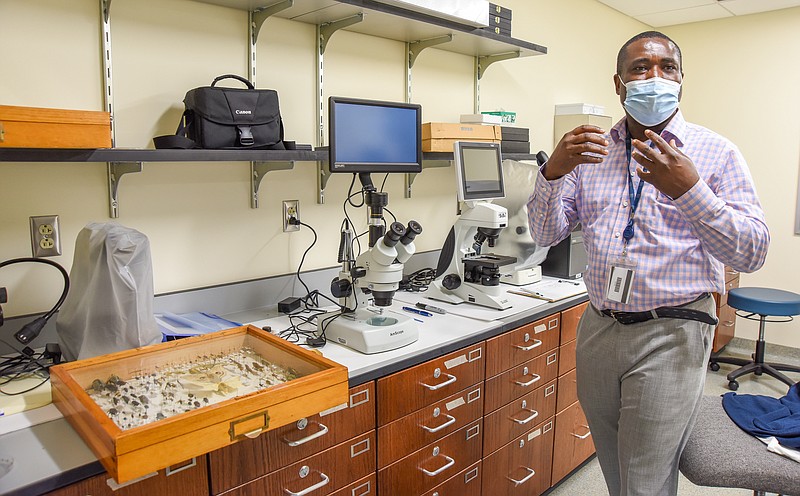Lincoln University's agricultural research is set to flourish under its new Dickinson Research Facility.
LU celebrated the opening of its new research facility with a ribbon cutting ceremony Thursday, complete with light refreshments, remarks from university stakeholders, faculty presentations, and tours of the laboratory and greenhouses.
The new Dickinson Research Facility stands in the same location as the previous building that was destroyed by a fire in July 2015.
It features multiple research and teaching lab spaces, a classroom and three greenhouses, which is enough room for seven to 15 faculty researchers and multiple students and lab staff.
"It's a great day for us at Lincoln," interim President John Moseley said. "To rebuild from a fire and end up with a tremendous research facility that will be beneficial to not only our students and our research staff but many across our state."
"Agriculture has been one of our leading programs for many years, so we see this as being a place that can attract students that want to come in and study things that can benefit Missourians," he added.
Moseley said the community's support helped restore the research facility back on campus and make it one of the best facilities at the university.
The lab and greenhouses will be primary research spaces for LU's College of Agriculture, Environmental and Human Sciences, which incorporates the university's cooperative research and extension.
"It's something that our researchers and our students can benefit from, and as a result of that, communities that they serve and farmers all across this state and agriculture leaders all across this state will benefit from the activities that take place inside," Moseley said.
The cooperative research and extension provides stakeholders, like Missouri farmers, cutting edge research in the field of agriculture, some of which was on display Thursday.
Clement Akotsen-Mensah, an LU assistant professor and state extension specialist for integrated pest management, will be using the new facility to conduct research on how to control invasive species of insects without the overuse of pesticides.
"You don't want to buy a blueberry with a maggot nobody wants that so we're trying to help the farmers to be able to control that and then avoid selling infested fruit," Akotsen-Mensah said.
He said he also advises farmers on how to preserve insects that are beneficial to plant growth, like bees, and which insects are harmful and require the use of pesticide.
Akotsen-Mensah said the new facility and its equipment, like modern microscopes, allow researchers to gather better data and draw better conclusions.
Akotsen-Mensah isn't the only researcher benefiting from the facility's new equipment.
One of the new temperature-controlled greenhouses contains corn, hemp and soybean for research, like soil and environmental professor Frieda Eivazi's research on slow-release fertilizers made from wastewater and animal manure.
The fertilizer is activated by the plant's roots and its use of wastewater and manure could help the state cut down on pollution sources.
"Maybe in three weeks or so we'll see some, hopefully, visual differences in these plants here," Eivazi said.
Researchers at the Dickinson Research Facility are also conducting ground-breaking research into the nutritional value of quinoa greens the leaves and stems of the popular grain.
Quinoa could become a beneficial specialty crop for Missouri farmers to increase their income as the greens can be harvested multiple times from the same plant, they have a short growing season, can survive drought conditions, and can be grown in both organic and conventional farming systems, Safiullah Pathan, LU assistant professor of crop science, said.
Lincoln University's Hemp Institute, one of Missouri's leading institutions researching genetic characteristics and crop management practices for hemp fiber, grains and flowers, is also housed at the Dickinson Research Facility.
Babu Valliyodan, Hemp Institute chair and assistant professor of molecular biology and genomics, said the institute recently received a United States Department of Agriculture grant to develop industrial hemp for the Midwest.
Valliyodan said LU researchers are collecting the state's various naturally growing hemp, studying its genetics and growing the different varieties to determine which is most fit for survival in the state. The work will culminate in determining how Missouri farmers can best grow their own variety of hemp for fiber, grains and flowers.
"It's a brand new facility, and I love it because it's a state of the art facility," said Jaimin Patel, LU assistant professor of plant pathology. "We have really good microscopes and stereoscopes that you can look at microscopic microorganisms and really how they affect the plants. It's really amazing to see."

